Safe Overtaking of Cyclists in Windy Conditions: Rules and Risks Explained
In windy conditions, safely overtake cyclists by giving them extra space and avoiding abrupt maneuvers to reduce the risk of pushing them off balance.

Contents
- Safe Overtaking of Cyclists in Windy Conditions: Rules and Risks Explained
- Why Is It Dangerous To Pass A Cyclist When Overtaking?
- How To Overtake A Cyclist?
- Why Is Dealing With Wind So Challenging?
- How Can I Stay Safe When There Are Wind Warnings?
- How to Stay in Your Lane When It’s Windy?
- That’s A Wrap!
- FAQ
- In windy conditions should I sound my horn to pass a cyclist?
- Do cyclists use any particular hand signals when it’s windy outside?
- When operating a truck or bus in windy conditions what safety measures to take?
- Can I use my hazard lights to warn other cars and cyclists when I’m driving in a windy situation?
- Is there a recommended speed limit for driving in windy circumstances?
It’s important to share the road with cyclists. But it can be dangerous to pass them particularly when it’s windy. Let’s highlight the risks and provide safety tips.
Why Is It Dangerous To Pass A Cyclist When Overtaking?
Overtaking a cyclist comes with its own risks. Here are some risks you can face when overtaking cyclists:
Sudden Movements: Unexpected swerving is a maneuver that cyclists can use to avoid road debris or uneven surfaces.
Low Visibility: Especially in their blind spots drivers may not be able to see the cyclist clearly.
Proximity: Cyclists may be forced off the road or clipped by cars when they pass too closely.
How To Overtake A Cyclist?
Examine your surroundings: Make sure there is adequate room for you to pass the cyclist both ahead and behind before doing so. Check the road conditions and keep an eye out for oncoming traffic.
Signal your intentions: Indicate what you intend to do by using your turn signal to let other drivers know that you intend to pass. This lets the cyclist know that you intend to move around them and also warns other drivers of your intention.
Give plenty of space: Make sure you leave enough room between your car and the cyclist. To protect them and to give room for any unexpected movements try to keep a minimum of 1. 5 meters distance.
Pass cautiously: Only enter the other lane when it is safe to do so when passing. Make sure there’s enough room to pass without cutting off the cyclist and keep an eye out for any oncoming cars.
Return to your lane safely: Make a safe return to your lane by signaling and cautiously reentering it after you have passed the cyclist. Before you cross back over make sure there is adequate room between your car and the cyclist.
Why Is Dealing With Wind So Challenging?
Powerful Gusts: It may be challenging to keep a safe distance between your car and the cyclist as the wind pushes your vehicle in their direction.
Cyclist Instability: Wind can interfere with a rider’s equilibrium and make them more likely to swerve.
Debris Hazards: Road debris can pose a hazard to drivers and cyclists alike. Wind can carry debris onto the roadway.
How Can I Stay Safe When There Are Wind Warnings?
Slow Down: Put in more time to react to wind gusts and unforeseen circumstances by slowing down.
Increase Following Distance: Give the cyclist more room in your car than normal.
Be Watchful: Keep a close eye on the cyclist and prepare for any unexpected movements.
How to Stay in Your Lane When It’s Windy?
Retain A Firm Grip: To prevent your car from being pushed by wind gusts hold the steering wheel firmly.
Remain In Your Lane: Prevent swerving or making sudden corrections. As this may put the cyclist in danger!
Wait For A Safe Opportunity: When the wind becomes too strong wait for a safe opportunity to pass. You can also wait until there is a sheltered spot or calmer conditions.
That’s A Wrap!
Remember, it is everyone’s responsibility to drive safely. You can contribute to the safety of bicyclists other drivers and yourself on the road by heeding this advice and exercising extra caution when driving in windy conditions.
FAQ
1. In windy conditions should I sound my horn to pass a cyclist?
In general, it’s not advised to honk your horn in order to pass a cyclist. Because it might frighten them and cause mishaps! Rather keep a safe distance and pass when it’s appropriate.
2. Do cyclists use any particular hand signals when it’s windy outside?
It is true that in windy conditions cyclists may indicate their intentions more clearly. Comparable to indicating turns or abrupt movements with hand signals. It is important for drivers to be alert and conscious of these signals.
3. When operating a truck or bus in windy conditions what safety measures to take?
Strong winds can have a greater impact on larger vehicles so it’s important to drive extra carefully. Add even more distance to the following distance. Consider how the size of the vehicle may affect cyclists. Additionally, think about delaying overtaking until the best circumstances exist.
4. Can I use my hazard lights to warn other cars and cyclists when I’m driving in a windy situation?
Typically emergency and danger lights are used to signal a threat. Extremely windy conditions may lead to some drivers using them. The goal is to raise awareness and visibility. But you have to use them wisely. It can be confusing for other drivers when hazard lights are used improperly.
5. Is there a recommended speed limit for driving in windy circumstances?
When driving in windy conditions there is no set speed limit. However in order to keep better control of your car it’s advisable to slow down below the posted limit. Particularly while passing cyclists. Always modify your speed according to the conditions of the road and the weather.


